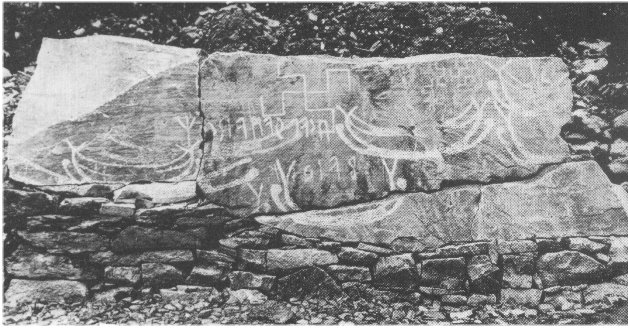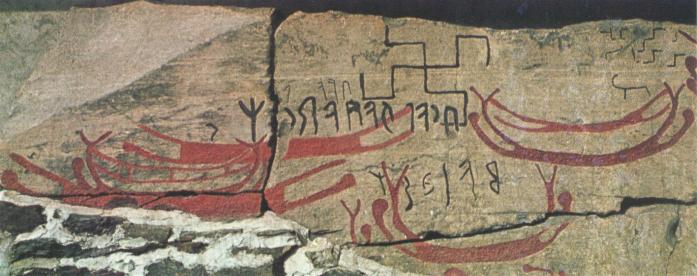Lesbians in a Strange Land?
Migrating Lesbians may have carved two 5th century runic inscriptions in Norway
In 1898 on a rock cliff face in Kaerstad, Norway, a road construction crew discovered two very curious runic inscriptions dated to approximately 425-450 AD. Unfortunately they had broken the inscription into several large pieces before realizing what they had found. Still the main inscriptions are quite legible, appearing just below an extended swastika (the early Germanic sun-wheel), and surrounded by carvings of ships (which were apparently made quite some time later, as the patina on the ship carvings is lighter and therefore newer than that of the runes; also one of the ships was carved over the lower inscription, rendering it difficult to read the letters). Apparently these two inscriptions were written by women, and I believe they were quite possibly lovers.

Black and white photo of the Kaerstad stone

Colorized photo, emphasizing the earlier runic inscriptions (black)
and the later carvings of the ships (red);
inscriptions were carved right
to left; above reads: EKALJAMARK[I]Z and below reads: BAIJOZ
Written in ancient Germanic (the predecessor of such languages as English, Dutch, Swedish, Gothic, Yiddish etc.) the first runic inscription reads: ek aljamarkiz, or "I am [an] out-marker" (possibly fem. sing.?) meaning a foreigner, a woman from outside the "mark" or known territory (as in Denmark - the territory of the Danes). The second inscription, obviously carved by a different hand, reads: baijoz, or most literally " together, we two" (fem. plur.) Since the word baijoz is feminine plural, this further implies that the person who wrote the first inscription was also female. We can interpret this second inscription to mean that both women were foreigners to the Kaerstad area, or simply that the two of them are now together, or a combination of both. In any case, there is an immediate intimacy to this latter inscription that I find very moving; an insistent declaration of the strong bond of these two women.
These inscriptions are of special interest to scholars because they are two of the very few runic inscriptions known to have been carved by women. However, no scholars who are aware of these inscriptions have theorized that the two women may have been lovers.
The runes are a Germanic alphabet roughly based on the Greek alphabet. Anciently, each runic letter was carved onto a piece of wood from a fruit-bearing tree (usually oak) and then used to cast lots and make divinations. The runes themselves are rather Queer (in the sexual sense) in view of their mythological and historical transgendered background, and because the ancient Germanic tribe who spread the runes over Europe were known to have been predominantly homosexual.
In Norse mythology, the runes were first ruled by the fertility goddess Freja (after whom Friday is named, i.e. Freya's Day) and only women were allowed to cast runes in order to make divinations. The chief male god of the Norse, Odin (after whom Wednesday is named, i.e. Woden's Day) begged of Freja to learn the secrets of the runes until she finally relented. The price Odin had to pay was to hang upside-down by one leg for nine days and nights from the World Tree, without food or water. At the dawn of the tenth day, Odin saw the runes inscribed on pieces of wood begin to bubble up from the bottom of the pond which lay at the roots of the World Tree. "Howling, I took them up!" cries Odin in one poetic rendering of this tale. From then on, using the runes for divination became primarily a man's vocation.
While this story of Odin makes for exciting narrative drama, in fact there is historical evidence for this transgendering of the divinatory use of runes. Julius Caesar, when he was in what is now France and Germany battling the Celts and affiliated Germanic tribes in 58 BC, he noted that the mater familia (clan matriarch) was called on to perform oracles to determine whether a tribe should do battle or not. 150 years later, the Roman ethnographer Tacitus described in detail the process by which Germanic peoples used runes to cast divinations. However Tacitus explicitly wrote that at his time it was the pater familia (clan patriarch) who was called on to cast the runes.
A tribe of Gay nomadic pirates and mercenaries called the Eruloz (or Heruli, as the Romans recorded) apparently found the runes in the Scythian territories near the Ukraine and the Crimea around 100 BC. As this fierce tribe of nomadic homosexuals terrorized Europe for the next 700 years, they carried the runes with them, spreading them wherever they traveled until all Germanic tribes were using the runes to make inscriptions on wooden wands, cliff faces, funeral stelae, and rings and other pieces of jewelry. At least 12 inscriptions left by these homosexual warriors dating from 200-600 AD are still extent, mostly found in Scandinavia. Almost all 12 inscriptions follow the pattern of ek erilaz, "I am Heruli" (masc. sing.) followed by the name or nickname of the rune scribe. Interestingly, the ek aljamarkiz inscription found at Kaerstad seems to mimic this pattern intentionally, although emphasizing that the women were not Heruli, but foreigners of some unspecified tribe instead.
For more scholarly information on the Germanic runes, see for example Maureen Halsall's The Old English Rune Poem: A Critical Edition and Ralph Elliot's Runes: An Introduction. As to books on the runes by neo-pagans like Freya Aswynn, while interesting to some extent, I find their fanciful reconstructions based more on fantasy than fact, so do be judicious in what you read and believe.